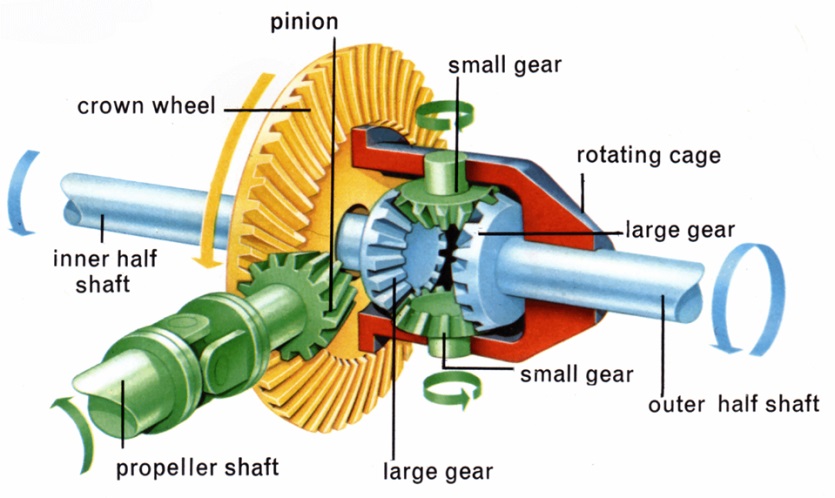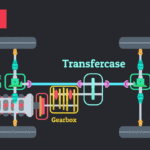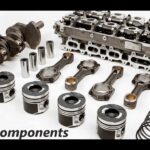Torque is supplied from the engine, via the transmission, to a drive shaft (British term: ‘propeller shaft’, commonly and informally abbreviated to ‘prop-shaft’), which runs to the final drive unit that contains the differential. A spiral bevel pinion gear takes its drive from the end of the propeller shaft, and is encased within the housing of the final drive unit. This meshes with the large spiral bevel ring gear, known as the crown wheel. The crown wheel and pinion may mesh in hypoid orientation, not shown. The crown wheel gear is attached to the differential carrier or cage, which contains the ‘sun’ and ‘planet’ wheels or gears, which are a cluster of four opposed bevel gears in perpendicular plane, so each bevel gear meshes with two neighbours, and rotates counter to the third, that it faces and does not mesh with. The two sun wheel gears are aligned on the same axis as the crown wheel gear, and drive the axle half shafts connected to the vehicle’s driven wheels. The other two planet gears are aligned on a perpendicular axis which changes orientation with the ring gear’s rotation.

Input torque is applied to the ring gear (blue), which turns the entire carrier (blue). The carrier is connected to both the side gears (red and yellow) only through the planet gear (green) (visual appearances in the diagram notwithstanding). Torque is transmitted to the side gears through the planet gear. The planet gear revolves around the axis of the carrier, driving the side gears. If the resistance at both wheels is equal, the planet gear revolves without spinning about its own axis, and both wheels turn at the same rate.

If the left side gear (red) encounters resistance, the planet gear (green) spins as well as revolving, allowing the left side gear to slow down, with an equal speeding up of the right side gear (yellow).
Thus, for example, if the vehicle is making a turn to the right, the main crown wheel may make 10 full rotations. During that time, the left wheel will make more rotations because it has further to travel, and the right wheel will make fewer rotations as it has less distance to travel. The sun gears (which drive the axle half-shafts) will rotate in opposite directions relative to the ring gear by, say, 2 full turns each (4 full turns relative to each other), resulting in the left wheel making 12 rotations, and the right wheel making 8 rotations.
The rotation of the crown wheel gear is always the average of the rotations of the side sun gears. This is why, if the driven roadwheels are lifted clear of the ground with the engine off, and the drive shaft is held (say leaving the transmission ‘in gear’, preventing the ring gear from turning inside the differential), manually rotating one driven roadwheel causes the opposite roadwheel to rotate in the opposite direction by the same amount.

When the vehicle is traveling in a straight line, there will be no differential movement of the planetary system of gears other than the minute movements necessary to compensate for slight differences in wheel diameter, undulations in the road (which make for a longer or shorter wheel path), etc.

· This is a depiction of an open differential, which is commonly found in most vehicles. They are quite trouble-free, but do have one disadvantage. On a dry road with good traction, the power is evenly applied to both wheels. When one of the tires hits ice or a slippery surface, it begins to spin and the majority of torque is directed to the spinning wheel, leaving very little for the wheel with the good traction. This is how vehicles can get stuck in snow or mud.
· Another type of differential is the limited slip differential, which is an option on most new cars. It has a distinct advantage by having a set of clutches and springs within the differential. Their function is to apply pressure to the side gears should one of the tires begin to slip. By applying pressure to the opposite wheel from the one spinning, it allows for more torque to be applied to the wheel with traction. If is far superior to the open differential when it comes to traction in bad weather.


